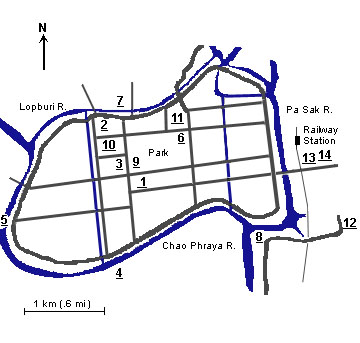Located 85 km (53 mi) north of Bangkok, Ayutthaya – pronounced
"eye-YOU-tee-uh," and romantically named after Rama's legendary
city – served as the Thai capital from 1350 to 1767,
when it was razed to the ground in an orgy of destruction
by Burmese invaders. The city was founded in 1350 by Prince Ramathibodi of U-Thong, on an island formed by the confluence of the Lopburi,
Pa Sak, and Chao Phraya rivers. Excellently situated both for
defense and for trade, Ayutthaya soon absorbed Sukhothai and
expanded into the most powerful military and commercial empire of its time, dominating the old Khmer heartland of central Southeast Asia. At its greatest extent in the 17th century, the city was home to over one million people, conducted diplomatic relations with the France of Louis XIV, and was said to rival in magnificence the cities of
Paris, London, and even Venice (see two ancient canals in blue color, running north-south, in the map above). After the sack of 1767, Ayutthaya became a ghost town, its entire populace having been killed, displaced, or shipped off into slavery.
In art, as in politics and warfare, Ayutthaya was deeply
influenced by the earlier Khmer empire, of which Ayutthaya became
the natural successor. Khmer ideas of kingship, military organization,
and trade powered the Ayutthayan imperial expansion. In architecture,
the prangs of Ayutthayan temples
elongate and simplify the basic form of the Khmer tower. In
sculptures, especially of the Buddha, Khmer influence (both directly, and indirectly via U-Thong) can be seen in
the replacement of Sukhothai mannerism by a more straightforward
aesthetic. Later, the Ayutthaya style
transforms into an elaborated form of decoration. With
the addition of realistic elements, particularly from
Victorian Europe, this develops eventually into Bangkok style.
Archaeological sites in Ayutthaya
were restored in the 19th and 20th centuries. Very little remains of the old royal palace, so I have not
included any photographs of that site (#2 on the map above). Rebuilt temples and chedis are concentrated around the central park and outer perimeter of the city. The rest of the town is modern, having been slowly repopulated after the catastrophe of 1767. It is easy to get to the sites by tuk-tuk (motorized cart), with the help of an inexpensive and useful site guidebook (Ayutthaya, by Chaiwat Worachetwarawat).

